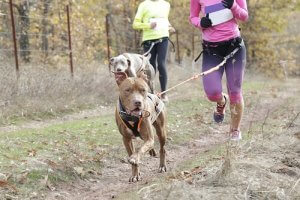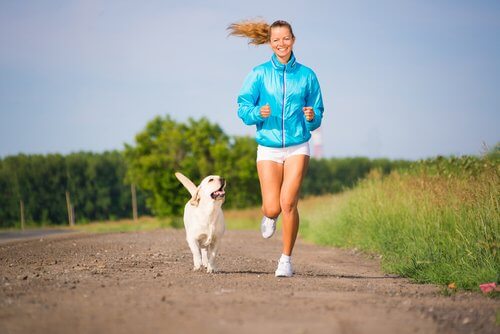Meet Leia The Dog: A Canicross Champion

Working out with your dog has multiple benefits, both for you and your pet. Many people go out for a run or a walk with their pets by their side. This fact led to the creation of a competition called “Canicross”. In this article, we’ll tell you about this interesting discipline. In addition, we’ll talk about the story of a dog called Leia, a big star of these races and nothing less than a Canicross champion.
What is Canicross?
There are thousands of people who love to exercise in the company of their pets. Undoubtedly, this is a very pleasant activity for both parties. The combination of the passion for running with the love for dogs, led to the creation of a new sport called Canicross. It’s so popular in Europe that it has even spread to other parts of the world.
This discipline has its origins in sled dog racing, mostly practiced by Husky dogs. Sled dog racing is very popular in countries with long hard winters. In fact, it’s becoming more and more famous on European ski tracks.

Canicross integrates aspects from athletics, cross-country, and mountain running (where owners tie themselves with a harness and an elastic cord to their pets). It may seem a bit cruel to the animals, but they usually really enjoy the activity.
Fans of this new sport say that their dogs really enjoy running. To them, there’s nothing better than to be able to practice a sport with their best friends. In addition, they always have a great time while training. In order to be able to practice Canicross, there must be a great pet-owner communication and bonding. A good physical condition on both sides is also an important factor.
About Canicross
First things first: the dog owner attaches a harness to their dog and, after that, hooks him/herself to the dog by the waist. The owner is responsible for maintaining the same running rhythm as the dog to avoid them straining too much. In addition, it’s against the rules for the owner to run in front of the animal.
Although there are no breed restrictions, the pet must be free from any disease or disability. A written certificate from a veterinarian allowing for exercise is required, to show that the pet has all the yearly vaccinations and controls.
Canicross races won’t take place if temperatures exceed 68°F. In these cases, exercise can be deadly for dogs if they get too hot. In fact, a federation regulating the competitions already exists in Europe. Both the human’s and the dog’s health and well being are important and it’s necessary to take all precautions.
The story of Leia: The Canicross champion

Now that you know what Canicross is – a sport in which the human-dog relationship is crucial – we’d like to tell you about Leia. She’s more than just a special dog, and we can learn a great deal about her story.
This beautiful mixed-breed dog (with some French Poodle ancestry according to its owner) is a true Canicross champion. She has run three races and has won them all. However, she’s going for more as she trains to beat her own records. She has even beaten larger sized dogs with longer legs, some of the league’s best competitors.
Hugo Gomez is Leia’s partner in this adventure. Hugo is a professional runner who competed in France’s Mont Blanc, and has passed on the love for the sport to his pet since she was a small puppy.
In the Colombian city of Cali, where they live, Leia Maria is a superstar. Her owner says he gave her those names because she’s a Star Wars fan! When she was adopted, Gomez says the dog didn’t stop running around the house.
A champion at heart
Since she was so restless, Hugo began to take her to the park so that she could run every day and release all that energy. This became a habit and is now almost a profession. In addition, her first competition took place when Leia was only 7 months old, and she got fifth place!
She is undoubtedly a four-legged athlete who teaches us a great lesson: if we have determination and effort, we can achieve anything that we want!
Working out with your dog has multiple benefits, both for you and your pet. Many people go out for a run or a walk with their pets by their side. This fact led to the creation of a competition called “Canicross”. In this article, we’ll tell you about this interesting discipline. In addition, we’ll talk about the story of a dog called Leia, a big star of these races and nothing less than a Canicross champion.
What is Canicross?
There are thousands of people who love to exercise in the company of their pets. Undoubtedly, this is a very pleasant activity for both parties. The combination of the passion for running with the love for dogs, led to the creation of a new sport called Canicross. It’s so popular in Europe that it has even spread to other parts of the world.
This discipline has its origins in sled dog racing, mostly practiced by Husky dogs. Sled dog racing is very popular in countries with long hard winters. In fact, it’s becoming more and more famous on European ski tracks.

Canicross integrates aspects from athletics, cross-country, and mountain running (where owners tie themselves with a harness and an elastic cord to their pets). It may seem a bit cruel to the animals, but they usually really enjoy the activity.
Fans of this new sport say that their dogs really enjoy running. To them, there’s nothing better than to be able to practice a sport with their best friends. In addition, they always have a great time while training. In order to be able to practice Canicross, there must be a great pet-owner communication and bonding. A good physical condition on both sides is also an important factor.
About Canicross
First things first: the dog owner attaches a harness to their dog and, after that, hooks him/herself to the dog by the waist. The owner is responsible for maintaining the same running rhythm as the dog to avoid them straining too much. In addition, it’s against the rules for the owner to run in front of the animal.
Although there are no breed restrictions, the pet must be free from any disease or disability. A written certificate from a veterinarian allowing for exercise is required, to show that the pet has all the yearly vaccinations and controls.
Canicross races won’t take place if temperatures exceed 68°F. In these cases, exercise can be deadly for dogs if they get too hot. In fact, a federation regulating the competitions already exists in Europe. Both the human’s and the dog’s health and well being are important and it’s necessary to take all precautions.
The story of Leia: The Canicross champion

Now that you know what Canicross is – a sport in which the human-dog relationship is crucial – we’d like to tell you about Leia. She’s more than just a special dog, and we can learn a great deal about her story.
This beautiful mixed-breed dog (with some French Poodle ancestry according to its owner) is a true Canicross champion. She has run three races and has won them all. However, she’s going for more as she trains to beat her own records. She has even beaten larger sized dogs with longer legs, some of the league’s best competitors.
Hugo Gomez is Leia’s partner in this adventure. Hugo is a professional runner who competed in France’s Mont Blanc, and has passed on the love for the sport to his pet since she was a small puppy.
In the Colombian city of Cali, where they live, Leia Maria is a superstar. Her owner says he gave her those names because she’s a Star Wars fan! When she was adopted, Gomez says the dog didn’t stop running around the house.
A champion at heart
Since she was so restless, Hugo began to take her to the park so that she could run every day and release all that energy. This became a habit and is now almost a profession. In addition, her first competition took place when Leia was only 7 months old, and she got fifth place!
She is undoubtedly a four-legged athlete who teaches us a great lesson: if we have determination and effort, we can achieve anything that we want!
This text is provided for informational purposes only and does not replace consultation with a professional. If in doubt, consult your specialist.








